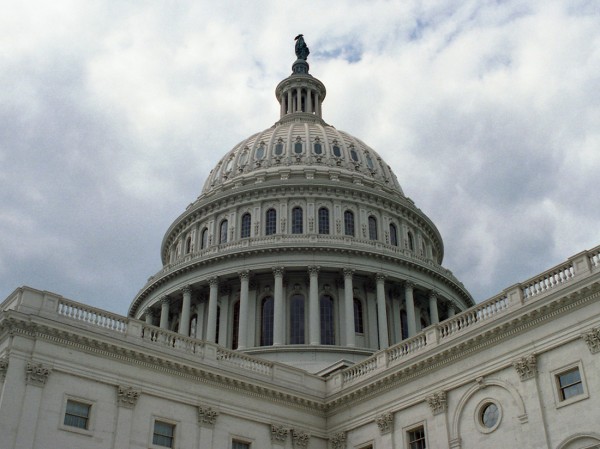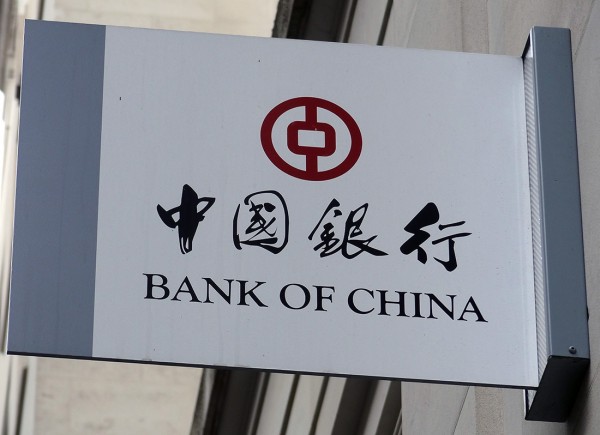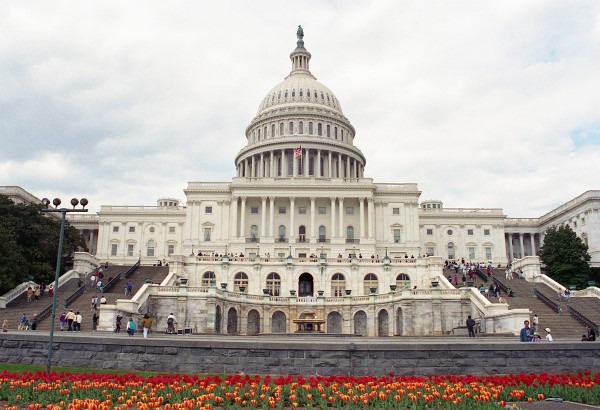 You may have been following the posts on the US debt ceiling and budget crisis: Over the cliff and Over the cliff: an update. Well, after considerable brinkmanship over the past couple of weeks, and with the government in partial shutdown since 1 October thanks to no budget being passed, a deal was finally agreed by both Houses of Congress, less than 12 hours before the deadline of 17 October. This is the date when the USA would have bumped up against the debt ceiling of $16.699 trillion and would be in default – unable to borrow sufficient funds to pay its bills, including maturing debt.
You may have been following the posts on the US debt ceiling and budget crisis: Over the cliff and Over the cliff: an update. Well, after considerable brinkmanship over the past couple of weeks, and with the government in partial shutdown since 1 October thanks to no budget being passed, a deal was finally agreed by both Houses of Congress, less than 12 hours before the deadline of 17 October. This is the date when the USA would have bumped up against the debt ceiling of $16.699 trillion and would be in default – unable to borrow sufficient funds to pay its bills, including maturing debt.
But the deal only delays the problem of a deeply divided Congress, with the Republican majority on the House of Representatives only willing to make a long-term agreement in exchange for concessions by President Obama and the Democrats on the healthcare reform legislation. All that has been agreed is to suspend the debt ceiling until 7 February 2014 and fund government until 15 January 2014.
A more permanent solution is clearly needed: not just one that raises the debt ceiling before the next deadline, but one which avoids such problems in the future. Such concerns were echoed by Christine Lagarde, Managing Director of the International Monetary Fund (IMF), who issued the following statement:
The U.S. Congress has taken an important and necessary step by ending the partial shutdown of the federal government and lifting the debt ceiling, which enables the government to continue its operations without disruption for the next few months while budget negotiations continue to unfold.
It will be essential to reduce uncertainty surrounding the conduct of fiscal policy by raising the debt limit in a more durable manner. We also continue to encourage the U.S. to approve a budget for 2014 and replace the sequester with gradually phased-in measures that would not harm the recovery, and to adopt a balanced and comprehensive medium-term fiscal plan.
US default: Congress votes to end shutdown crisis The Telegraph, Raf Sanchez (17/10/13)
US shutdown: Christine Lagarde calls for stability after debt crisis is averted The Guardian,
James Meikle, Paul Lewis and Dan Roberts (17/10/13)
America’s economy: Meh ceiling? The Economist (15/10/13)
Relief as US approves debt deal BBC News (17/10/13)
Shares in Europe dip after US debt deal BBC News (17/10/13)
Dollar slides as relief at U.S. debt deal fades Reuters, Richard Hubbard (17/10/13)
US debt deal: Analysts relieved rather than celebrating Financial Times, John Aglionby and Josh Noble (17/10/13)
Greenspan fears US government set for more debt stalemate BBC News (21/10/13)
Questions
- Explain what is meant by default and how the concept applies to the USA if it had not suspended or raised its budget ceiling.
- Is the agreement of October 16 likely to ‘reassure markets’? Explain your reasoning.
- What is likely to happen to long-term interest rates as a result of the agreement?
- Will the imposition of a new debt ceiling by February 2014 remove the possibility of using fiscal policy to stimulate aggregate demand and speed up the recovery?
- What is meant by ‘buy the rumour, sell the news’ in the context of stock markets? How was this relevant to the agreement on the US debt ceiling and budget?
 Investment is essential for the growth of any economy, but none more so for an economy recovering from a severe downturn, such as the UK. Not only will it bring in much needed money and then create jobs for UK residents, but it will also continue to build ties between the UK and the world’s fastest growing economy.
Investment is essential for the growth of any economy, but none more so for an economy recovering from a severe downturn, such as the UK. Not only will it bring in much needed money and then create jobs for UK residents, but it will also continue to build ties between the UK and the world’s fastest growing economy.
George Osborne has been in China promoting business opportunities for investment in the UK and one such investment is into Manchester Airport. The ‘Airport City’ Project will be a combined effort, or a Joint Venture, between the Greater Manchester Pension Fund, the UK’s Carillion Plc and Beijing Construction Engineering Group. The plan is to create offices, hotels, warehouses and manufacturing firms, bringing in thousands of jobs in the process, thus providing a much needed boost to the British economy. Britain is already one of the top nations attracting Chinese investment, with more than double the amount of any other European nation. George Osborne is clearly in favour of further improving business ties with China, saying:
I think it shows that our economic plan of doing more business with China and also making sure more economic activity in Britain happens outside the City of London is working…That’s good for Britain and good for British people.
 However, the benefit of such investment from China into the UK, is not just of benefit to our domestic economy. China will also reap benefits from its involvement in projects, such as the development of Manchester’s airport. The Managing Director of BCEG, Mr Xing Yan, said:
However, the benefit of such investment from China into the UK, is not just of benefit to our domestic economy. China will also reap benefits from its involvement in projects, such as the development of Manchester’s airport. The Managing Director of BCEG, Mr Xing Yan, said:
To be included in such an interesting and unique development is a real honour…We see our involvement in Airport City as an extension of the memorandum of understanding between China and the UK, where we have been looking to further explore joint infrastructure opportunities for some time.
The airport investment by China is only one of many of its recent forays into the UK economy. Other investments include plans to rebuild London’s Crystal Palace and plans to create a third financial district near London’s City Airport.
Some may see more Chinese involvement in UK business as a threat, but for most it is viewed as an opportunity. An opportunity that both Boris Johnson and George Osborne will undoubtedly exploit as far as possible, with the hope that it will generate income, employment and growth. The following articles consider this investment opportunity.
Manchester Airport Group announces jobs boost The Telegraph, David Millward (13/10/13)
China’s BCEG joins UK Manchester airport joint venture Reuters (13/10/13)
Manchester Airport to receive investment from China BBC News (13/10/13)
George Osborne hails China’s airport investment The Telegraph (13/10/13)
Chinese group in $1.2bn British airport development deal The Economic Times (13/10/13)
China in £800m Manchester airport deal Financial Times, Elizabeth Rigby and Lucy Hornby (13/10/13)
Boris and Osborne in China to push trade Sky News, Mark Stone (13/10/13)
What does China own in Britain? BBC News (14/10/13)
Questions
- What is a joint venture? What are the advantages and disadvantages of a joint venture relative to other business structures?
- How important are political ties with China?
- Do you view Chinese investment in the UK as an opportunity or a threat? Make a list for each side of the argument, ensuring you offer explanations for each reason.
- What macroeconomic benefits will the development of the Manchester Airport bring to the city?
- Will there be wider economic benefits to the rest of the UK, despite the investment being located in Manchester?
- Using the AD/AS model, illustrate and explain why investment is so important to the recovery of the UK economy.
 In a News Item of 1 October, Over the Cliff, we looked at the passing of the deadline that same day for Congress to agree a budget. We also looked at the looming deadline for Congress to agree a new higher ceiling for Federal Government debt, currently standing at $16.699 trillion. Without an agreement to raise the limit, the government will start becoming unable to pay some of its bills from around 17 October.
In a News Item of 1 October, Over the Cliff, we looked at the passing of the deadline that same day for Congress to agree a budget. We also looked at the looming deadline for Congress to agree a new higher ceiling for Federal Government debt, currently standing at $16.699 trillion. Without an agreement to raise the limit, the government will start becoming unable to pay some of its bills from around 17 October.
One week on and no agreement has been reached on either a budget or a higher debt ceiling.
 Failure to agree on a budget has led to the ‘shut-down’ of government. Only essential services are being maintained; the rest are no longer functioning and workers have been sent home on ‘unpaid leave’. This has led to considerable hardship for many in the USA. It has had little effect, however, on the rest of the world, except for tourists to the USA being unable to visit various national parks and monuments.
Failure to agree on a budget has led to the ‘shut-down’ of government. Only essential services are being maintained; the rest are no longer functioning and workers have been sent home on ‘unpaid leave’. This has led to considerable hardship for many in the USA. It has had little effect, however, on the rest of the world, except for tourists to the USA being unable to visit various national parks and monuments.
Failure to raise the debt ceiling, however, could have profound consequences for the rest of the world. It could have large and adverse effects of global growth, global trade, global investment and global financial markets. The articles below explore some of these consequences.
U.S. Congress enters crucial week in budget, debt limit battles Reuters, Richard Cowan (7/10/13)
Debt ceiling: Understanding what’s at stake CBS Moneywatch, Alain Sherter (7/10/13)
Q&A: What is the US debt ceiling? BBC News, Ben Morris (3/10/13)
Five Reasons to Fear the Debt Ceiling Bloomberg (6/10/13)
A U.S. Default Seen as Catastrophe Dwarfing Lehma Bloomberg Businessweek, Yalman Onaran (6/10/13)
China tells US to avoid debt crisis for sake of global economy BBC News (7/10/13)
US shutdown is starting to hit business, says Commerce Secretary BBC News (6/10/13)
Why Australia should fear a US government default The Guardian, Greg Jericho (7/10/13)
Could the US default over just $6bn? BBC News, Linda Yueh (11/10/13)
IMF piles pressure on US to reconcile differences and prevent debt default The Guardian, Larry Elliott and Jill Treanor (10/10/13)
Republicans offer to raise US debt ceiling for six weeks The Telegraph, Peter Foster and Raf Sanchez (11/10/13)
Questions
- If a debt ceiling is reached, what does this imply for the budget deficit?
- How serious are the two current fiscal cliffs?
- How would a continuation of the partial government shut-down impact on the US private sector?
- What multiplier effects on the rest of the world are likely to arise from a cut in US government expenditure or a rise in taxes? What determines the size of these multiplier effects?
- Explain the likely effect of the current crisis on the exchange rate of the dollar into other currencies.
- Why might the looming problem of reaching the debt ceiling drive up long-term interest rates in the USA and beyond?
 ‘Farm-gate’ milk prices (the price paid to farmers) have been rising in the UK. In July they reached a record high of 31.4p per litre (ppl). This was 5.1ppl higher than in July 2012. There were further price rises this month (October). Sainsbury’s increased the price it pays farmers by nearly 2ppl to 34.15ppl and Arla Foods by 1.5ppl to 33.13ppl. Muller Wiseman is set to raise the price it pays to 32.5p per litre.
‘Farm-gate’ milk prices (the price paid to farmers) have been rising in the UK. In July they reached a record high of 31.4p per litre (ppl). This was 5.1ppl higher than in July 2012. There were further price rises this month (October). Sainsbury’s increased the price it pays farmers by nearly 2ppl to 34.15ppl and Arla Foods by 1.5ppl to 33.13ppl. Muller Wiseman is set to raise the price it pays to 32.5p per litre.
And yet many farmers are struggling to make a profit from milk production, claiming that their costs have risen faster than the prices they receive. Feed costs, for example, have risen by 2.12ppl. On average, farmers would need over 38p per litre just to cover their average variable costs. What is more, exceptional weather has reduced yields per cow by some 7%.
Meanwhile, in the USA, supply has risen by some 1.3% compared with a year ago. But despite this, the prices of dairy products are rising, thanks to strong demand. Cheese and butter prices, in particular, are rising rapidly, partly because of high demand from overseas. Demand for imported dairy products is particularly high in China, where supply has fallen by some 6% in the past couple of months.
 The problem for dairy farmers in the UK is partly one of the power balance in the industry. Farmers have little or no market power. Supermarkets, however, have considerable market power. As large oligopsonistic buyers, they can put downward pressure on the prices paid to their suppliers. These are mainly large processing firms, such as Robert Wiseman Dairies, Arla Foods and Dairy Crest. They, in turn, can use their market power to keep down the price they pay to farmers.
The problem for dairy farmers in the UK is partly one of the power balance in the industry. Farmers have little or no market power. Supermarkets, however, have considerable market power. As large oligopsonistic buyers, they can put downward pressure on the prices paid to their suppliers. These are mainly large processing firms, such as Robert Wiseman Dairies, Arla Foods and Dairy Crest. They, in turn, can use their market power to keep down the price they pay to farmers.
Articles
Dairy farmers renew protests over milk prices Farmers Weekly, Philip Case (5/9/13)
Dairy farmers ‘lost more than 1p/litre last year’ Farmers Weekly, Philip Case (2/10/13)
South West farming businesses and producers still making a loss on milk South West Business (3/10/13)
Q&A: Milk prices row and how the system works BBC News (23/7/12) (note date of this)
Positive Dairy Trend: Rising Milk Production and Strong Demand The Farmer’s Exchange, Lee Mielke (27/9/13)
Chinese supply crisis to delay dairy price adjustment Rabobank (25/9/13)
China milk ‘crisis’ fuels world dairy price rise Agrimoney (1/10/13)
Data
UK milk prices and composition of milk ONS
Combined IFCN world milk price indicator IFCN
Questions
- Give some examples of (a) variable costs and (b) fixed costs in milk production.
- Why may farmers continue in dairy production, at least for a time, even if they are not covering their average variable costs?
- What factors determine (a) the price of milk paid to farmers; (b) the retail price in supermarkets?
- Explain how dairy futures markets work.
- Could the milk processors use their market power in the interests of farmers? Is it in the interests of milk processors to do so?
- Why is there a Chinese “dairy supply crisis”? What is its impact on the rest of the world? What is the relevance of the price elasticity of demand for dairy products in China to this impact?
 For the second time in nine months, the USA has approached a fiscal cliff. This is where the federal government is forced to make government expenditure cuts and/or impose tax rises. There are two types of cliff face. The first is a legal limit on the size of the federal government debt and hence deficit. The second is failure to agree on a budget.
For the second time in nine months, the USA has approached a fiscal cliff. This is where the federal government is forced to make government expenditure cuts and/or impose tax rises. There are two types of cliff face. The first is a legal limit on the size of the federal government debt and hence deficit. The second is failure to agree on a budget.
On January 1st this year, a fiscal cliff was narrowly averted by a last-minute agreement to raise the size of the permitted debt. On the 1st October (the beginning of the financial year), however, the US economy ‘fell over the cliff’. This time is was a failure by Congress to reach agreement over the federal budget. The sticking point was an unwillingness of the Republican majority in the House of Representatives to agree to a budget without the government making concessions on its healthcare reform. The government was unwilling to do that and so no budget was passed.
With no budget, much of government has to shut down! In practice, this means that all non-essential workers will cease to be paid.  That includes workers in housing, parts of healthcare, the civil law part of the justice system, immigration, regulatory agencies, the passport service, parks and museums. Even workers in essential areas, such as civilian workers in the military, police and social services, are likely to see their pay delayed until the problem is resolved. The articles below look at some of the implications of this partial shut-down.
That includes workers in housing, parts of healthcare, the civil law part of the justice system, immigration, regulatory agencies, the passport service, parks and museums. Even workers in essential areas, such as civilian workers in the military, police and social services, are likely to see their pay delayed until the problem is resolved. The articles below look at some of the implications of this partial shut-down.
It is hoped that, within a few days, agreement on a budget will be reached. But that will not be the end of the story because a second fiscal cliff looms. And that is of the first type. There is currently a legal limit to Federal Government debt of $16.699 trillion. Because that limit was reached earlier this year, from May 18 the government has been able to use various ‘extraordinary measures‘ to carry on borrowing. These measures will run out, however, around 17 October. From then, if a new higher debt ceiling has not been agreed by Congress, the government will be unable to pay some of its bills. For example, on 1 November it will get a bill of $67billion for social security, medicare and veterans benefits. As the second Independent article below explains:
In a government shutdown, the federal government is not allowed to make any new spending commitments. By contrast, if we hit the debt-ceiling then the Treasury Department won’t be able to borrow money to pay for spending that Congress has already approved. In that case, either Congress will have to lift the debt ceiling or the federal government will have to default on some of its bills, possibly including payments to bondholders or Social Security payouts. That could trigger big disruptions in the financial markets — or a long-term rise in borrowing costs.
Not surprisingly, financial markets are nervous. Although the direct effect of lost output will be relatively small, provided agreements on the budget and the debt are reached fairly soon, the impact on confidence in the US system of government could be more damaging. Not only could this curb recovery in the USA, it could have a significant effect on global recovery, given the size and importance of the US economy to the rest of the world.
Webcasts
 What does the shutdown mean for normal Americans? BBC News, Keith Doyle (1/10/13)
What does the shutdown mean for normal Americans? BBC News, Keith Doyle (1/10/13)
 How the government shut down is being reported in the US BBC News (1/10/13)
How the government shut down is being reported in the US BBC News (1/10/13)
 Shutdown could slam frail U.S. economy Reuters, Bobbi Rebell (1/10/13)
Shutdown could slam frail U.S. economy Reuters, Bobbi Rebell (1/10/13)
 Shutdown Will Cost U.S. Economy $300 Million a Day, IHS Says Bloomberg, Jeanna Smialek & Ian Katz (1/10/13)
Shutdown Will Cost U.S. Economy $300 Million a Day, IHS Says Bloomberg, Jeanna Smialek & Ian Katz (1/10/13)
 How will the US government shutdown affect the global economy? The Guardian, Larry Elliott and Guy Grandjean (1/10/13)
How will the US government shutdown affect the global economy? The Guardian, Larry Elliott and Guy Grandjean (1/10/13)
 How would a government shutdown affect the rebounding economy? Aljazeera, Duarte Geraldino (30/9/13)
How would a government shutdown affect the rebounding economy? Aljazeera, Duarte Geraldino (30/9/13)
 How will the US government shutdown affect the economy? BBC News, Richard Lister (1/10/13)
How will the US government shutdown affect the economy? BBC News, Richard Lister (1/10/13)
 Shutdown continues as Obama and Republicans fail to agree BBC News, Rajini Vaidynathan (2/10/13)
Shutdown continues as Obama and Republicans fail to agree BBC News, Rajini Vaidynathan (2/10/13)
 Former US Secretary of Labor Robert Reich on shutdown BBC News, Robert Reich (2/10/13)
Former US Secretary of Labor Robert Reich on shutdown BBC News, Robert Reich (2/10/13)
 Government shutdown: What’s the cost? CBS News, Rebecca Kaplan (1/10/13)
Government shutdown: What’s the cost? CBS News, Rebecca Kaplan (1/10/13)
 US shutdown will have ‘minimal impact’ on global economy One News (New Zealand), Dan Zirker (2/10/13)
US shutdown will have ‘minimal impact’ on global economy One News (New Zealand), Dan Zirker (2/10/13)
 What is the US debt ceiling? BBC News, Hugh Pym (14/10/13)
What is the US debt ceiling? BBC News, Hugh Pym (14/10/13)
Articles
US wakes up to government shutdown as Congress fails to strike budget deal Independent, Nikhil Kumar (1/10/13)
US begins government shutdown as budget deadline passes BBC News (1/10/13)
David Cameron warns on world growth as US government shuts down The Telegraph, Damien McElroy (1/10/13)
Shutdown showdown: A glossary Aljazeera, Ben Piven (30/9/13)
Everything you need to know about how the partial shutdown will work in US Independent, Brad Plumer (1/10/13)
What’s the economic impact of a US government shutdown? BBC News, Kim Gittleson (1/10/13) (follow links at top of screen for further articles)
US government shutdown isn’t the worst of it BBC News, Linda Yueh (30/9/13)
Onset of the storm BBC News, Robert Peston (1/10/13)
The gathering storm? BBC News, Robert Peston (30/9/13)
Government shutdown: what’s really going on – and who’s to blame? The Guardian, Dan Roberts (30/9/13)
Government shutdown threat is getting very old, very fast CNN, Julian Zelizer (30/9/13)
US fiscal cliff fears rattle the markets The Australian, Adam Creighton (1/10/13)
U.S. Government Shutdown Sinks Dollar Forbes, Dean Popplewell (1/10/13)
US Government Shutdown: European Markets Not Fretting Over Temporary Closure International Business Times, Ishaq Siddiqi (1/10/13)
The States to plunge into abyss of debt, off fiscal cliff Pravda, Irina Sabinina (1/10/13)
Shutting down the United States government nothing new The Vancouver Sun, Andrew Coyne (1/10/13)
Christine Lagarde urges US that debt crisis threatens world economy The Guardian, Larry Elliott (3/10/13)
U.S. failure to lift debt ceiling could damage world – IMF Reuters (3/10/13)
Data
US government shutdown: in numbers The Guardian (see also)
US Budget: Historical Tables White House Office of Management and Budget (includes estimates to 2018 as well as historical data)
Questions
- If a debt ceiling is reached, what does this imply for the budget deficit?
- How serious are the two current fiscal cliffs?
- How would a continuation of the partial government shut-down impact on the US private sector?
- What multiplier effects on the rest of the world are likely to arise from a cut in US government expenditure or a rise in taxes? What determines the size of these multiplier effects?
- Explain the likely effect of the current crisis on the exchange rate of the dollar into other currencies.
- Why might the looming problem of reaching the debt ceiling drive up long-term interest rates in the USA and beyond?
 You may have been following the posts on the US debt ceiling and budget crisis: Over the cliff and Over the cliff: an update. Well, after considerable brinkmanship over the past couple of weeks, and with the government in partial shutdown since 1 October thanks to no budget being passed, a deal was finally agreed by both Houses of Congress, less than 12 hours before the deadline of 17 October. This is the date when the USA would have bumped up against the debt ceiling of $16.699 trillion and would be in default – unable to borrow sufficient funds to pay its bills, including maturing debt.
You may have been following the posts on the US debt ceiling and budget crisis: Over the cliff and Over the cliff: an update. Well, after considerable brinkmanship over the past couple of weeks, and with the government in partial shutdown since 1 October thanks to no budget being passed, a deal was finally agreed by both Houses of Congress, less than 12 hours before the deadline of 17 October. This is the date when the USA would have bumped up against the debt ceiling of $16.699 trillion and would be in default – unable to borrow sufficient funds to pay its bills, including maturing debt. 





